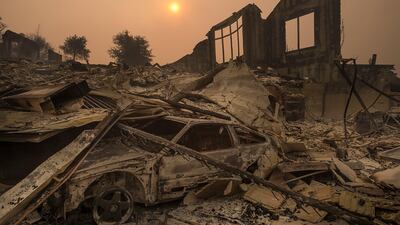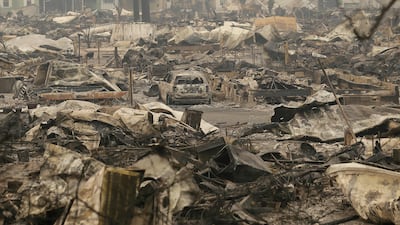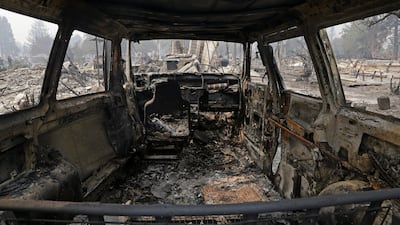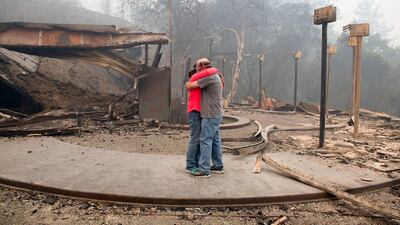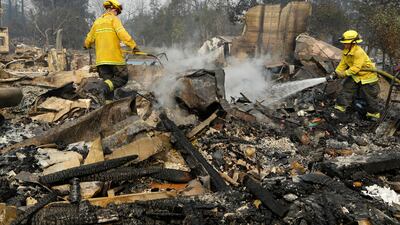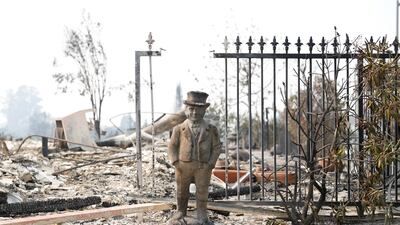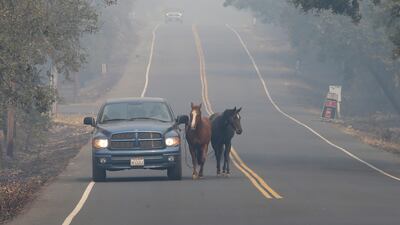— Jose Garnica worked for more than two decades to build up his dream home that was reduced to ashes in a matter of minutes by the deadly firestorm striking Northern California. Garnica, who moved to the US from Mexico over 20 years ago, had finally decided he could afford to upgrade parts of his Santa Rosa house after building a stable career with the local garbage company and saving nearly everything he and his wife earned. Over the past two years, he replaced the siding and installed a new air conditioner, stainless steel appliances and new flooring.
A carelessly discarded cigarette, a downed power line, a car's backfire or a chainsaw's pull. Just about anything could have started any one of the wildfires now tearing through Northern California, authorities said.
"Every spark is going to ignite a fire," said Ken Pimlott, the state's top firefighter. He said the risk remains "extreme for new starts".
Mr Pimlott said that investigators are looking into the causes, but no determination has been made at any of the 17 sites of major wildfires blazing in Northern California. The California Department of Forestry and Fire Protection director, said "98 per cent" of all wildfires are started by people and it's unlikely lightning is to blame for any of the fires that exploded overnight Sunday, killing at least 17 people so far.
_______________
Read more:
As natural disasters increase, insurance industry feels strain
Deadly wildfires sweep through California
Gallery: World in focus for October 10, 2017
_______________
California's most dangerous wildfire season comes in autumn, when summer heat and insects have left brush dead and dried out, and winds are especially hot, dry and strong.
"This is traditionally California's worst time for fires," Mr Pimlott said.
Firefighters typically respond to 300 blazes a week during this season, but nearly all are extinguished quickly and with minimal damage. It's unusual to have many major fires burning at once, he said.
However, conditions were ripe for wildfires in California wine country after record rains last winter created an abundance of dry vegetation, which combined with low humidity and unusually high winds to create fast-moving infernos.
Firefighters battling wildfires in California's wine country face the prospect of new outbreaks with dry, windy conditions returning to an area where at least 17 people have been killed and 2,000 homes and businesses destroyed in blazes.
Gusts of up to 80 kph and 10 percent humidity were forecast for late Wednesday and into Thursday for the region where 17 fires have forced 20,000 people to flee their homes, fire officials said. "The potential for new fires that could grow exponentially as these fires did in such a short time period is there," said Lynne Tolmachoff, spokeswoman for the California Department of Forestry and Fire Protection.
None of the major fires has been contained. They are spread over a 320-kilometre region north of San Francisco from Napa in the south to Redding in the north, taxing firefighting resources.
"Our primary effort is going to put containment lines in as quickly as possible," Mr Pimlott said on Tuesday.
Napa County Fire Chief Barry Biermann said fires had been moving too fast and unpredictably for firefighters to attack directly.
"The winds were extremely erratic during those conditions of high winds and a lot of things happened." He and others said resources are stretched thin as firefighters battle so many major blazes simultaneously.
Some evacuations in Nevada and Yuba counties in western California were lifted on Tuesday while other evacuations to the east in Sonoma and Napa counties, where more than 50,000 acres burned, were expanded, Ms Tolmachoff said.
Some 155 people were still missing in Sonoma County, although 45 others had been found and some of those unaccounted for may be due to confusion surrounding evacuations.
The biggest and most devastating fire is burning in Santa Rosa a city of 175,000 people north of San Francisco. A fire there swept through several neighbourhoods and business districts, destroying at least 550 homes and 21 commercial buildings. Many residents had only minutes to flee. Eleven of the 17 fatalities found so far have occurred in and near Santa Rosa.
Irene Fonzeca and her husband Luis were spending their second night in shelter on Tuesday after the couple woke up to raging fire nearby that was being blown toward their home on Monday.
"The sound of fiery trees crashing down was terrifying, " Luis said. Wearing a breathing mask against the smoke and light ash, his wife added, "We have no idea what's there or if there's anything to go back to."
In the shelter, emotions were raw. "People are crying hugging helping each other. It's devastating," she said.
In Napa County, the dead included 100-year-old Charles Rippey and his wife, Sarah, 98. The couple were married for 75 years, according to their son, Mike. Charles Rippey's body was found outside where his wife's bedroom once stood, he said.
"He was trying to get from his room to her room," Mike Rippey said. "He never made it. Even if he had got there, he wouldn't have been able to get her out … And there is no way he would have left."
California Office of Emergency Services director Mark Ghilarducci said more than 4,000 firefighters, law enforcement officials and others are responding. Aeroplanes are dropping fire retardant and fresh firefighters from Southern California and Nevada are streaming in to help. Lines are being dug on the south side of many blazes in preparation for northerly winds picking up.
The US department of defence is sending a large drone to help map the fires and assess damage. The California National Guard is also providing petrol to firefighters and other emergency services because many service stations in the area are without power and unable to pump fuel.
California Highway Patrol officers are helping with security at evacuation centres and providing escorts to rescue vehicles travelling in dangerous areas, commissioner Warren Stanley said. He also had a request for motorists in the area:
"Anybody who is driving around — if you're smoking in your car — please do not throw your cigarettes out the window."
